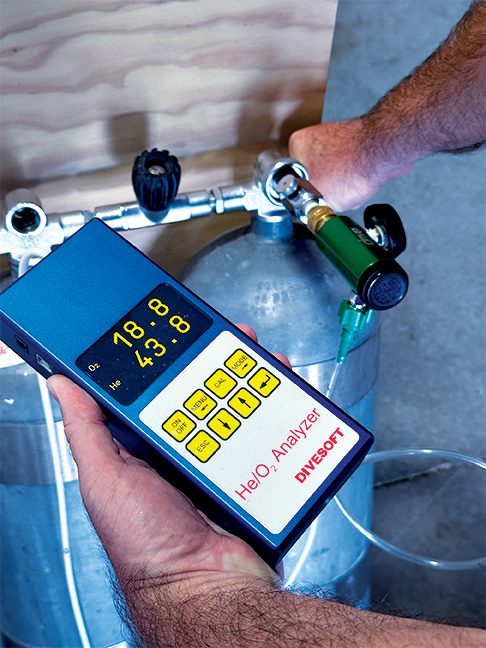THE THREE GASES GENERALLY used in recreational and technical diving are oxygen, nitrogen, and helium. Nitrogen is the most abundant and is usually the default gas, but no one seems concerned about its purity, although the U.S. Compressed Gas Association (CGA) provides purity levels, or grades, for various applications.
Helium is the most expensive. It makes up less than 0.001 percent of our planet’s atmosphere, or 50 parts per million (ppm), and it liquefies at an extreme temperature of –452°F (–269°C). Helium is the second most abundant gas in the universe, and our sun produces hundreds of tons of it each second. Since we can’t harvest solar helium, we rely on radioactive decay to produce what we need. Fortunately, the form we extract is entirely stable.
When considering the purity of helium that divers should consider when making their gas blends, the commodity specification for helium (CGA G-9.1) conveniently uses “diving/respiratory applications.” The specification covers a range of what we refer to as grades, or quality verification levels, which define the required purity and allowable contaminant levels. Each batch of helium is analyzed to determine if it meets the minimum levels for a particular grade.
Balloon grade H is the least pure at 97.5 percent. That is quite pure for breathing purposes, but the trouble is that the standards for that grade do not catch all potential contaminants. It could contain 0.025 percent (250 ppm) carbon monoxide (CO), and you would not know it until you ascend from 60 feet and start to feel terrible.
Next is medical grade J, which meets a 99.0 percent minimum specification and is certified to have CO less than 0.001 percent (10 ppm). This grade is also safe for a breathing-gas mix, but only at the surface. Like oxygen, this is considered a drug and requires a medical prescription for purchase.
We can skip grade L, referred to as welding gas. Grade N helium has a purity level of 99.997 percent, which means potential contaminants of only 30 ppm, and it is the grade that the CGA considers suitable for diving and respirator applications.
It’s important to remember that all these gases, used for everything from balloon to diving applications, are produced as pure helium. The only difference is what the analysis looks for during the verification process.
We do not want excessive amounts of contaminants that will affect human physiology at depth, so we need to purchase diving-grade helium. Even medical grade helium has a remaining 1 percent, which is 10,000 ppm, that could contain something we don’t want to breathe at pressure.
Using helium with a total impurity level of 30 ppm ensures that we are breathing a safe gas mix. AD

© Alert Diver — Q3 2023